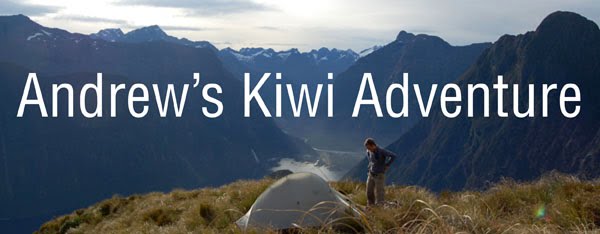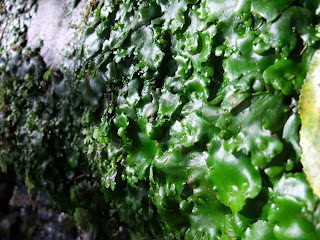I think I may have done a blog entry about Mt. Iron already, but I will talk about it some more: Mt. Iron is a small mountain that towers over the east side of Wanaka. The walking path, which goes up one side and down the other, is very popular due to it's ease and it's proximity to the town. The view from the top also makes the trip worth it.
 Just to add some difficulty to our walk, we decided to walk to Mt. Iron, not drive. It was a really pretty day so we felt inclined. This picture was taken on Aubrey Rd in the construction zone where they have built a foot path. A lot of the city has no sidewalks, which makes commuting by foot muddy. As we walked, we passed houses with dogs in the yards barking at us. There was one dog that had been locked on a second story balcony, which was a great place for it to bark at us from. We also passed many well-behaved dogs too and we talked about how great it would have been to have our own dog for a day, just to make the walk more fun.
Just to add some difficulty to our walk, we decided to walk to Mt. Iron, not drive. It was a really pretty day so we felt inclined. This picture was taken on Aubrey Rd in the construction zone where they have built a foot path. A lot of the city has no sidewalks, which makes commuting by foot muddy. As we walked, we passed houses with dogs in the yards barking at us. There was one dog that had been locked on a second story balcony, which was a great place for it to bark at us from. We also passed many well-behaved dogs too and we talked about how great it would have been to have our own dog for a day, just to make the walk more fun. At the foot of Mt. Iron is Allenby Park which is probably used for Football (Soccer) or other children's sporting events. We had to walk through the park in order to get to the Mt. Iron path and were delighted to meet a friendly border collie with no owner in sight. She seemed happy to see us and we were quite happy to see her. She was very curious and interested in us and rocked her head when we asked her where her owner was and whether she had a toy we could all play with. I decided it would be really fun to play fetch with her in the park so I started looking for a stick. Border collies are so smart; I swear she knew what I was looking for and she helped me search.
At the foot of Mt. Iron is Allenby Park which is probably used for Football (Soccer) or other children's sporting events. We had to walk through the park in order to get to the Mt. Iron path and were delighted to meet a friendly border collie with no owner in sight. She seemed happy to see us and we were quite happy to see her. She was very curious and interested in us and rocked her head when we asked her where her owner was and whether she had a toy we could all play with. I decided it would be really fun to play fetch with her in the park so I started looking for a stick. Border collies are so smart; I swear she knew what I was looking for and she helped me search. Andrea and I spent about 45 minutes throwing the stick for the dog and playing keep-away with her. She had a really funny way of playing with us. When she would fetch the stick, instead of giving it to us right away, she would stand so the stick was just out of reach. When we would lunge to grab it, instead of running away, she would just take a few steps back to keep the stick inches from our grasp. She would act uninterested in us, but still be measuring our distance from the corner of her eye.
Andrea and I spent about 45 minutes throwing the stick for the dog and playing keep-away with her. She had a really funny way of playing with us. When she would fetch the stick, instead of giving it to us right away, she would stand so the stick was just out of reach. When we would lunge to grab it, instead of running away, she would just take a few steps back to keep the stick inches from our grasp. She would act uninterested in us, but still be measuring our distance from the corner of her eye. She would even maneuver the stick in her mouth so that there was a long end that invited our grabbing attempts. After several of our failed attempts at recovering the stick, she would make it easier until one of us was eventually allowed the privilege to throw it for her again. She did not play tug-a-war, though; grabbing the stick sent her dashing down the field to retrieve it again. This game went on and on until we were both tired and ready to continue on our walk. We made a friend, indeed.
She would even maneuver the stick in her mouth so that there was a long end that invited our grabbing attempts. After several of our failed attempts at recovering the stick, she would make it easier until one of us was eventually allowed the privilege to throw it for her again. She did not play tug-a-war, though; grabbing the stick sent her dashing down the field to retrieve it again. This game went on and on until we were both tired and ready to continue on our walk. We made a friend, indeed. The dog's owner was nowhere to be found. We checked her tags to see if there was a phone number, but they only contained immunization records. From that point on, she followed us on our walk. She was our dog for the day– just what we had wished for.
The dog's owner was nowhere to be found. We checked her tags to see if there was a phone number, but they only contained immunization records. From that point on, she followed us on our walk. She was our dog for the day– just what we had wished for. As she followed us, she never wondering too far away. We named her Milly because I thought she looked like a Milly. She looked at us, puzzled, when we called her that name so we knew it wasn't right. We wished Milly could have told us her name– her eyes would meet ours as if she were ready to speak to us, but then she would dash into the woods, fueled by curiosity. As we walked up the mountain, we came across many other dogs, off lead, and Milly couldn't have been better with them. The last thing I wanted was for her to cause trouble and for Andrea and me to be blamed for the behavior of our supposed dog.
As she followed us, she never wondering too far away. We named her Milly because I thought she looked like a Milly. She looked at us, puzzled, when we called her that name so we knew it wasn't right. We wished Milly could have told us her name– her eyes would meet ours as if she were ready to speak to us, but then she would dash into the woods, fueled by curiosity. As we walked up the mountain, we came across many other dogs, off lead, and Milly couldn't have been better with them. The last thing I wanted was for her to cause trouble and for Andrea and me to be blamed for the behavior of our supposed dog. Here she is checking out the ancient rock formations meant to thank the gods for letting us climb on their sacred mountain.
Here she is checking out the ancient rock formations meant to thank the gods for letting us climb on their sacred mountain. Andrea tried to get a picture of me with Milly, but she wouldn't come to me when I called her so we had to time it so she was in the background.
Andrea tried to get a picture of me with Milly, but she wouldn't come to me when I called her so we had to time it so she was in the background. Here is the view of the Wanaka township from the top of Mt. Iron.
Here is the view of the Wanaka township from the top of Mt. Iron. On the way back down the mountain, Milly found another stick she wanted to play with, but we didn't throw it for her because we didn't want her to accidentally tumble down the mountain side.
On the way back down the mountain, Milly found another stick she wanted to play with, but we didn't throw it for her because we didn't want her to accidentally tumble down the mountain side. As we neared Allenby Park, we worried that Milly's owner would never show up and that she was going to follow us all the way home, but we were wrong. With perfect timing, her owner drove by with an open window calling, "Come Gracie!" It was a delightful treat to learn her real name! He parked his Subaru Outback in his driveway down the street, which was located next to the Mt. Iron walking path. This explains why she seemed to be leading the way up the mountain on our walk. I'm sure she has done the hike countless times. Her owner called her again from down the street. She seemed conflicted; she wanted to stay with us, but knew she had to obey her master. Immediately after this picture was taken, she trotted off, down the street, and back home. If only she knew how fantastic she made our day.
As we neared Allenby Park, we worried that Milly's owner would never show up and that she was going to follow us all the way home, but we were wrong. With perfect timing, her owner drove by with an open window calling, "Come Gracie!" It was a delightful treat to learn her real name! He parked his Subaru Outback in his driveway down the street, which was located next to the Mt. Iron walking path. This explains why she seemed to be leading the way up the mountain on our walk. I'm sure she has done the hike countless times. Her owner called her again from down the street. She seemed conflicted; she wanted to stay with us, but knew she had to obey her master. Immediately after this picture was taken, she trotted off, down the street, and back home. If only she knew how fantastic she made our day.Thank you, Gracie.















































